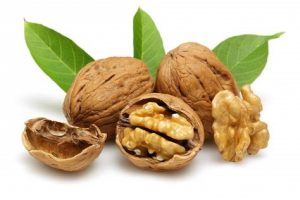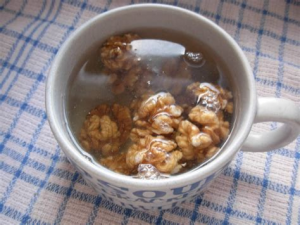If you want to make your arteries healthier, adding walnuts to your diet has been found to help. 
Researchers with Yale University’s Prevention Research Center asked two dozen men and women with type 2 diabetes to supplement their usual daily diets with 2 ounces of walnuts — about 30 shelled walnut halves — for eight weeks, then switch to a walnut-free diet (or vice versa). A test of blood flow through an artery in the forearm before and after each eight-week trial showed that walnuts improved the flexibility of the artery.
Studies have shown walnuts boost endothelial function.
A study in Barcelona conducted by Emilio Ros, MD, PhD, director of the Lipid Clinic at Hospital Clínico in Barcelona, Spain, took 24 randomized nonsmoking, middle-aged, healthy adults to one of two groups of 12. Each group was provided with two high-fat meals, eaten under supervision one week apart. The meals were identical, consisting of a salami-and-cheese sandwich on white bread and a small serving of full-fat yogurt. For one meal, the researchers added about five teaspoons (25 mL) of olive oil. For the other meal, they added 40 g of walnuts, or about eight shelled nuts.
Although both the olive oil and the walnuts lessened the sudden onset of inflammation and oxidation in the arteries it was discovered that walnuts helped preserve the elasticity and flexibility of the arteries.
It is also important to state that the inner lining of the arteries produces a substance called nitric oxide that is needed to keep the arteries flexible,” Dr. Ros said. “When we eat high-fat meals, the fat molecules temporarily disrupt the production of nitric oxide, preventing the arteries from increasing blood flow in response to physical activity.
One of the nutrients found in walnuts, he said, is arginine, an amino acid used by the body to produce nitric oxide.
How many ounces of walnuts should I eat a day? Good question!
According to Harvard Heart approximately one ounce of nuts daily can reduce your risk of heart disease. An ounce of walnuts is about a handful, or one-quarter cup. That amounts to between 12 and 14 halves or 30 grams of walnuts.
Here’s how to improve the nutrient benefits of walnuts
Walnuts should be soaked overnight (approximately 8-10 hours) because doing so makes them easier for the body to digest than eating them raw. The phytic acid found in nuts, which is reduced by soaking walnuts, contributes to increased absorption as well. The omega-3 fatty acids, known for their heart-healthy properties, are more readily absorbed when walnuts are soaked, boosting cardiovascular benefits.
Arterial elasticity and flexibility are markers of optimal cardiovascular health. Although there are other factors that will help in improving arterial elasticity such as eating heart-healthy plant based diet, eating wild fish (salmon), exercising for at least 30 to 60 minutes a day (150 minutes a week) and stopping smoking, something as simple as adding walnuts should be part of a total cardiovascular plan especially if your goal is to enjoy “the best performance of your life!”
God bless,
DrB
References:
ahajournals.org/doi/full/10.1161/01.CIR.0000124477.91474.FF
pcrm.org/news/health-nutrition/walnuts-improve-artery-flexibility
clinicaladvisor.com/home/news/walnuts-help-keep-arteries-elastic/
acc.org/About-ACC/Press-Releases/2010/02/22/16/39/17-1
psu.edu/news/research/story/walnuts-may-help-lower-blood-pressure-those-risk-heart-disease/
nature.com/articles/ejcn2010233
health.harvard.edu/newsletter_article/walnuts-and-arteries



